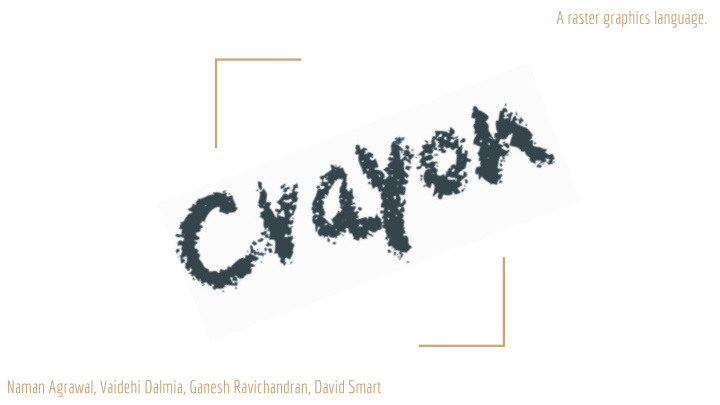



A raster graphics language. Naman Agrawal, Vaidehi Dalmia, Ganesh Ravichandran, David Smart
What is Crayon? - Crayon is a raster-graphics creation language that simplifies the digital painting of images through code. - Based on a matrix-layout of RGB pixels -> converted to a ppm file - Allows artistic expression through mathematical and algorithmic means
Why Pixels? - Rasterization allows the manipulation of each pixel’s color. - On the other hand, vector-images fill in objects with a single color. - Vector images are more scalable, but pixels allow for interesting color blends and programmer-friendly manipulation!
Goals for Crayon - Transparency: our intuitive Canvas type allows direct manipulation of the pixels of a ppm (Portable Pixmap) file. - Familiarity: the syntactic learning curve is low for those that know C; manipulating RGB values is as easy as using arrays. - Creativity: by making our language familiar and transparent, developers can create robust and interesting graphics programs.
So, What is a ‘Canvas’ Anyway? Essentially, it is a two-dimensional array, with 3-element arrays as RGB pixels.
So, What is a ‘Canvas’ Anyway? - The three element integer array (Pixel) represents an RGB value: - E.g. red = (255, 0, 0) in RGB notation = [255, 0, 0] as an element of a Canvas.
So, What is a ‘Canvas’ Anyway? - The Canvas is the exact same size as the ppm file that is generated. In this case 20x20 pixels.
So, What is a ‘Canvas’ Anyway? - Pixels can be accessed and assigned values quite intuitively. In this case 20x20 pixels.
Dude, Where’s My File? - Files can be created easily by passing in a Canvas pointer to our writefile function.
Dude, Where’s My File? The computer text version and the human eye version.
A Gentleman’s Guide to Canvas Pointers Declaring the pointer. Defining the pointer.
A Gentleman’s Guide to Canvas Pointers Dereferencing the pointer. Moving the pointer.
Our Types Primitive types: Non-Primitive types: - Int - Canvas - String - Array - Boolean - Pointer - Void
Project Plan - Agile (iterative) development approach - Lots of new decisions as new problems were encountered (e.g. adding pointers, not making Pixel a type) - Informal and formal testing at each stage to ensure complete functioning.
Timeline
Responsibilities
Testing - Test suites were run at each stage. - We adapted test cases from MicroC and added several of our own for types and standard library functions. - We adapted the testall.sh script from MicroC for automation.
Architecture Diagram Scanner Parser Semantic Generate Execute Checker LLVM LLVM AST
Thank you! Enjoy the demo! *Not created with Crayon, but maybe some day!
Recommend
More recommend